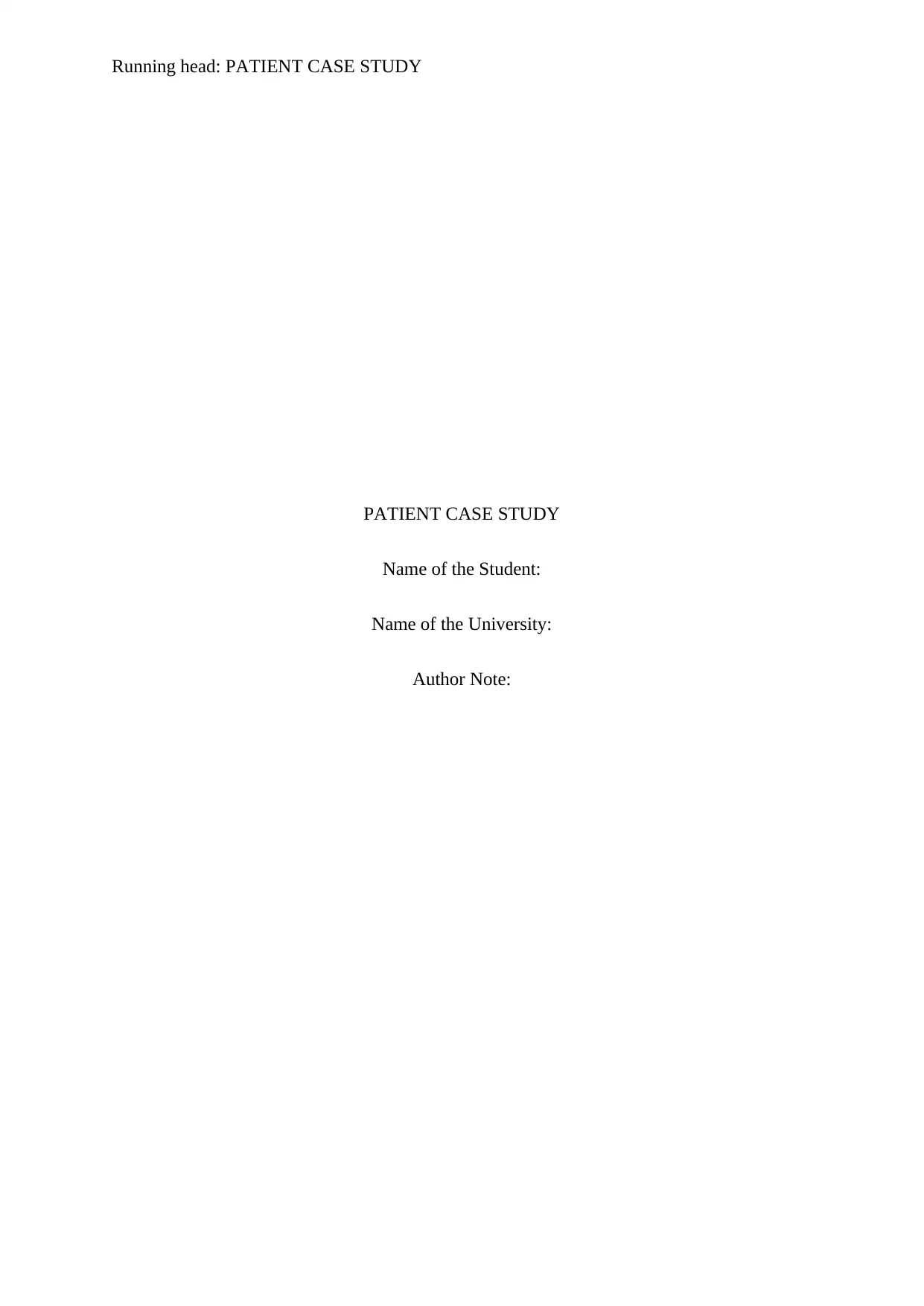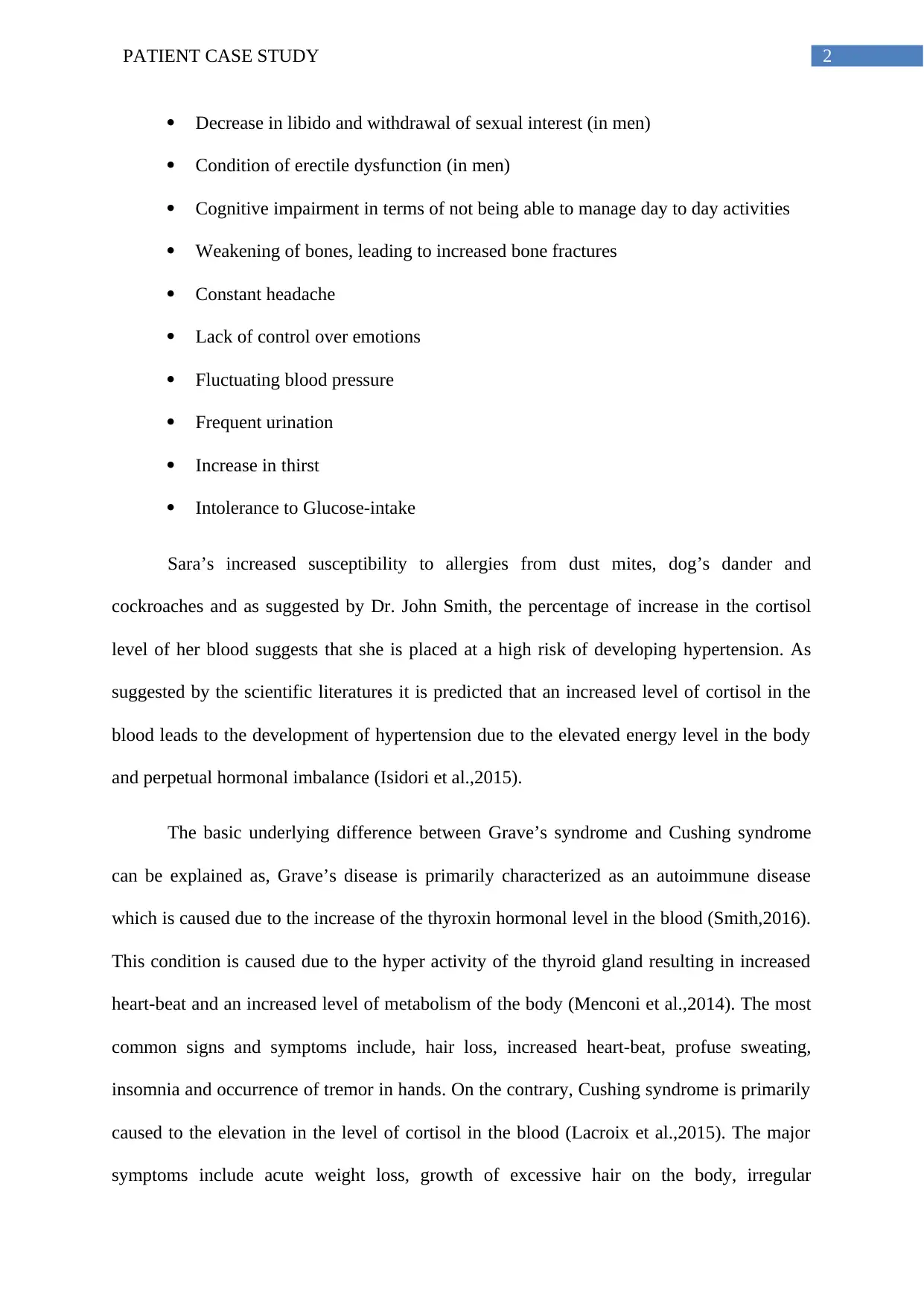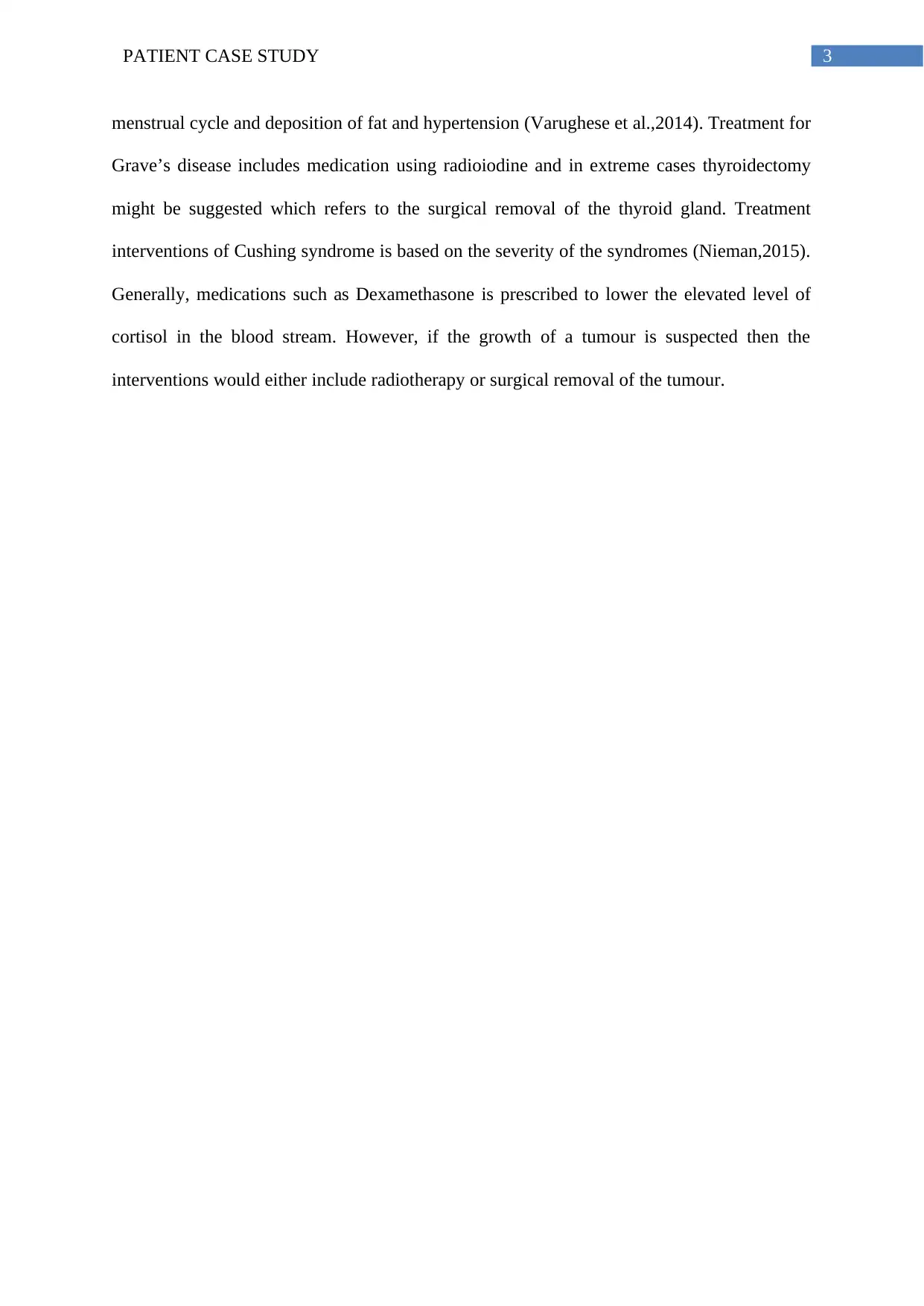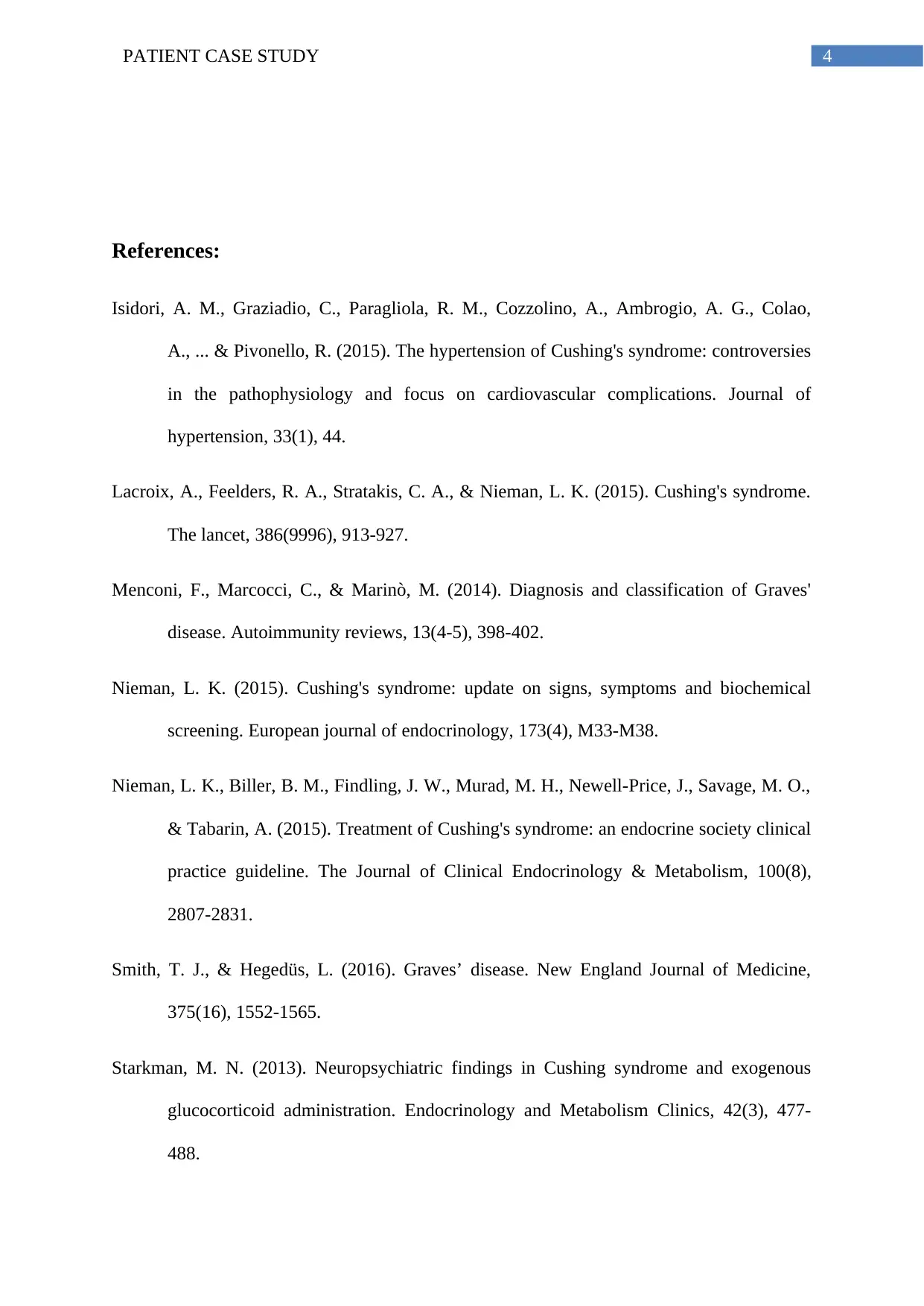NUR241 - Analysis of Sara Haines' Cushing Syndrome Case Study
VerifiedAdded on 2023/06/08
|6
|1002
|248
Case Study
AI Summary
This case study examines Sara Haines, a 38-year-old presenting with symptoms indicative of Cushing syndrome, including weight gain, facial hair growth, menstrual abnormalities, and increased thirst and appetite. The study identifies key signs and symptoms of Cushing syndrome, such as a fatty hump between the shoulders, round face, high blood pressure, and purplish stretch marks. It discusses Sara’s increased susceptibility to allergies and the potential for developing hypertension due to elevated cortisol levels. The case study differentiates Cushing syndrome from Grave’s disease, outlining their distinct causes, symptoms, and treatments, noting that Cushing syndrome treatment may involve medications like Dexamethasone or, in cases of tumors, radiotherapy or surgical removal. The document concludes with a list of references. Desklib provides access to similar case studies and solved assignments for students.

Running head: PATIENT CASE STUDY
PATIENT CASE STUDY
Name of the Student:
Name of the University:
Author Note:
PATIENT CASE STUDY
Name of the Student:
Name of the University:
Author Note:
Paraphrase This Document
Need a fresh take? Get an instant paraphrase of this document with our AI Paraphraser

1PATIENT CASE STUDY
With reference to the patient case as presented by the case study, the second and the
third question would be answered in the following paragraphs.
The primary signs of the manifestation of Cushing syndrome can be enlisted as
(Starkman,2013):
A significant fatty hump like structure present in between the shoulders
Round face
High blood pressure
Purplish or pinkish stretch marks
The primary symptoms that determine the presence of Cushing syndrome in patients can
be enlisted as under (Starkman,2013):
Excessive weight gain characterized by the presence of buffalo hump (a condition
when there are fat deposits in between the shoulders), moon shaped face and
deposition of fat around the midsection of the torso and the upper region of the
back.
Thinning of the skin prone to the manifestation of bruises easily
Severe acne manifestation
Reduction in healing power leading to slower healing of cuts and insect bites
Abnormal menstrual cycle pattern (in women)
Prevalence of Hirsutism ( condition marked by the presence of thicker hair on
skin)
Exhaustion and fatigue
Retarded physical growth in children
Persistent anxiety and depression and mood-swings
Decrease in fertility (in men)
With reference to the patient case as presented by the case study, the second and the
third question would be answered in the following paragraphs.
The primary signs of the manifestation of Cushing syndrome can be enlisted as
(Starkman,2013):
A significant fatty hump like structure present in between the shoulders
Round face
High blood pressure
Purplish or pinkish stretch marks
The primary symptoms that determine the presence of Cushing syndrome in patients can
be enlisted as under (Starkman,2013):
Excessive weight gain characterized by the presence of buffalo hump (a condition
when there are fat deposits in between the shoulders), moon shaped face and
deposition of fat around the midsection of the torso and the upper region of the
back.
Thinning of the skin prone to the manifestation of bruises easily
Severe acne manifestation
Reduction in healing power leading to slower healing of cuts and insect bites
Abnormal menstrual cycle pattern (in women)
Prevalence of Hirsutism ( condition marked by the presence of thicker hair on
skin)
Exhaustion and fatigue
Retarded physical growth in children
Persistent anxiety and depression and mood-swings
Decrease in fertility (in men)

2PATIENT CASE STUDY
Decrease in libido and withdrawal of sexual interest (in men)
Condition of erectile dysfunction (in men)
Cognitive impairment in terms of not being able to manage day to day activities
Weakening of bones, leading to increased bone fractures
Constant headache
Lack of control over emotions
Fluctuating blood pressure
Frequent urination
Increase in thirst
Intolerance to Glucose-intake
Sara’s increased susceptibility to allergies from dust mites, dog’s dander and
cockroaches and as suggested by Dr. John Smith, the percentage of increase in the cortisol
level of her blood suggests that she is placed at a high risk of developing hypertension. As
suggested by the scientific literatures it is predicted that an increased level of cortisol in the
blood leads to the development of hypertension due to the elevated energy level in the body
and perpetual hormonal imbalance (Isidori et al.,2015).
The basic underlying difference between Grave’s syndrome and Cushing syndrome
can be explained as, Grave’s disease is primarily characterized as an autoimmune disease
which is caused due to the increase of the thyroxin hormonal level in the blood (Smith,2016).
This condition is caused due to the hyper activity of the thyroid gland resulting in increased
heart-beat and an increased level of metabolism of the body (Menconi et al.,2014). The most
common signs and symptoms include, hair loss, increased heart-beat, profuse sweating,
insomnia and occurrence of tremor in hands. On the contrary, Cushing syndrome is primarily
caused to the elevation in the level of cortisol in the blood (Lacroix et al.,2015). The major
symptoms include acute weight loss, growth of excessive hair on the body, irregular
Decrease in libido and withdrawal of sexual interest (in men)
Condition of erectile dysfunction (in men)
Cognitive impairment in terms of not being able to manage day to day activities
Weakening of bones, leading to increased bone fractures
Constant headache
Lack of control over emotions
Fluctuating blood pressure
Frequent urination
Increase in thirst
Intolerance to Glucose-intake
Sara’s increased susceptibility to allergies from dust mites, dog’s dander and
cockroaches and as suggested by Dr. John Smith, the percentage of increase in the cortisol
level of her blood suggests that she is placed at a high risk of developing hypertension. As
suggested by the scientific literatures it is predicted that an increased level of cortisol in the
blood leads to the development of hypertension due to the elevated energy level in the body
and perpetual hormonal imbalance (Isidori et al.,2015).
The basic underlying difference between Grave’s syndrome and Cushing syndrome
can be explained as, Grave’s disease is primarily characterized as an autoimmune disease
which is caused due to the increase of the thyroxin hormonal level in the blood (Smith,2016).
This condition is caused due to the hyper activity of the thyroid gland resulting in increased
heart-beat and an increased level of metabolism of the body (Menconi et al.,2014). The most
common signs and symptoms include, hair loss, increased heart-beat, profuse sweating,
insomnia and occurrence of tremor in hands. On the contrary, Cushing syndrome is primarily
caused to the elevation in the level of cortisol in the blood (Lacroix et al.,2015). The major
symptoms include acute weight loss, growth of excessive hair on the body, irregular
⊘ This is a preview!⊘
Do you want full access?
Subscribe today to unlock all pages.

Trusted by 1+ million students worldwide

3PATIENT CASE STUDY
menstrual cycle and deposition of fat and hypertension (Varughese et al.,2014). Treatment for
Grave’s disease includes medication using radioiodine and in extreme cases thyroidectomy
might be suggested which refers to the surgical removal of the thyroid gland. Treatment
interventions of Cushing syndrome is based on the severity of the syndromes (Nieman,2015).
Generally, medications such as Dexamethasone is prescribed to lower the elevated level of
cortisol in the blood stream. However, if the growth of a tumour is suspected then the
interventions would either include radiotherapy or surgical removal of the tumour.
menstrual cycle and deposition of fat and hypertension (Varughese et al.,2014). Treatment for
Grave’s disease includes medication using radioiodine and in extreme cases thyroidectomy
might be suggested which refers to the surgical removal of the thyroid gland. Treatment
interventions of Cushing syndrome is based on the severity of the syndromes (Nieman,2015).
Generally, medications such as Dexamethasone is prescribed to lower the elevated level of
cortisol in the blood stream. However, if the growth of a tumour is suspected then the
interventions would either include radiotherapy or surgical removal of the tumour.
Paraphrase This Document
Need a fresh take? Get an instant paraphrase of this document with our AI Paraphraser

4PATIENT CASE STUDY
References:
Isidori, A. M., Graziadio, C., Paragliola, R. M., Cozzolino, A., Ambrogio, A. G., Colao,
A., ... & Pivonello, R. (2015). The hypertension of Cushing's syndrome: controversies
in the pathophysiology and focus on cardiovascular complications. Journal of
hypertension, 33(1), 44.
Lacroix, A., Feelders, R. A., Stratakis, C. A., & Nieman, L. K. (2015). Cushing's syndrome.
The lancet, 386(9996), 913-927.
Menconi, F., Marcocci, C., & Marinò, M. (2014). Diagnosis and classification of Graves'
disease. Autoimmunity reviews, 13(4-5), 398-402.
Nieman, L. K. (2015). Cushing's syndrome: update on signs, symptoms and biochemical
screening. European journal of endocrinology, 173(4), M33-M38.
Nieman, L. K., Biller, B. M., Findling, J. W., Murad, M. H., Newell-Price, J., Savage, M. O.,
& Tabarin, A. (2015). Treatment of Cushing's syndrome: an endocrine society clinical
practice guideline. The Journal of Clinical Endocrinology & Metabolism, 100(8),
2807-2831.
Smith, T. J., & Hegedüs, L. (2016). Graves’ disease. New England Journal of Medicine,
375(16), 1552-1565.
Starkman, M. N. (2013). Neuropsychiatric findings in Cushing syndrome and exogenous
glucocorticoid administration. Endocrinology and Metabolism Clinics, 42(3), 477-
488.
References:
Isidori, A. M., Graziadio, C., Paragliola, R. M., Cozzolino, A., Ambrogio, A. G., Colao,
A., ... & Pivonello, R. (2015). The hypertension of Cushing's syndrome: controversies
in the pathophysiology and focus on cardiovascular complications. Journal of
hypertension, 33(1), 44.
Lacroix, A., Feelders, R. A., Stratakis, C. A., & Nieman, L. K. (2015). Cushing's syndrome.
The lancet, 386(9996), 913-927.
Menconi, F., Marcocci, C., & Marinò, M. (2014). Diagnosis and classification of Graves'
disease. Autoimmunity reviews, 13(4-5), 398-402.
Nieman, L. K. (2015). Cushing's syndrome: update on signs, symptoms and biochemical
screening. European journal of endocrinology, 173(4), M33-M38.
Nieman, L. K., Biller, B. M., Findling, J. W., Murad, M. H., Newell-Price, J., Savage, M. O.,
& Tabarin, A. (2015). Treatment of Cushing's syndrome: an endocrine society clinical
practice guideline. The Journal of Clinical Endocrinology & Metabolism, 100(8),
2807-2831.
Smith, T. J., & Hegedüs, L. (2016). Graves’ disease. New England Journal of Medicine,
375(16), 1552-1565.
Starkman, M. N. (2013). Neuropsychiatric findings in Cushing syndrome and exogenous
glucocorticoid administration. Endocrinology and Metabolism Clinics, 42(3), 477-
488.

5PATIENT CASE STUDY
Varughese, A. G., Nimkevych, O., & Uwaifo, G. I. (2014). Hypercortisolism in obesity-
associated hypertension. Current hypertension reports, 16(7), 443.
Varughese, A. G., Nimkevych, O., & Uwaifo, G. I. (2014). Hypercortisolism in obesity-
associated hypertension. Current hypertension reports, 16(7), 443.
⊘ This is a preview!⊘
Do you want full access?
Subscribe today to unlock all pages.

Trusted by 1+ million students worldwide
1 out of 6
Related Documents
Your All-in-One AI-Powered Toolkit for Academic Success.
+13062052269
info@desklib.com
Available 24*7 on WhatsApp / Email
![[object Object]](/_next/static/media/star-bottom.7253800d.svg)
Unlock your academic potential
Copyright © 2020–2025 A2Z Services. All Rights Reserved. Developed and managed by ZUCOL.





